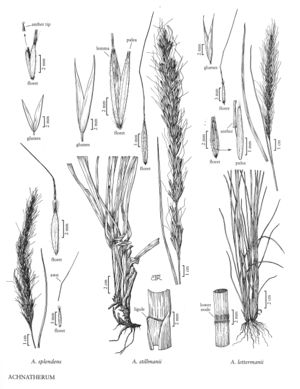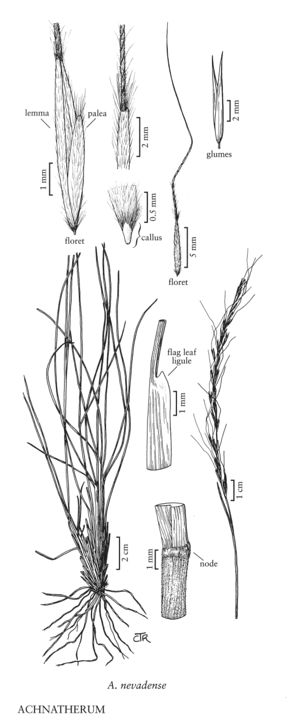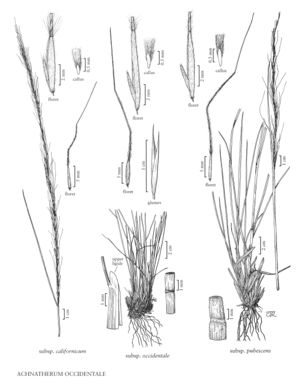Achnatherum
Plants perennial; tightly to loosely cespitose, sometimes shortly rhizomatous. Culms 10-250 cm, erect, not branching at the upper nodes; basal branching extra or intravaginal; prophylls shorter than the sheaths. Leaves sometimes concentrated at the base; sheaths open, margins often ciliate distally; cleistogenes not present in the basal leaf-sheaths; collars sometimes with hairs on the sides; auricles absent; ligules hyaline to membranous, glabrous or pubescent, sometimes ciliate; blades flat, convolute, or involute, apices acute, flexible, basal blades not overwintering, flag leaf-blades more than 10 mm long. Inflorescences terminal panicles, usually contracted, sometimes 2 forming at the terminal node; branches usually straight, sometimes flexuous. Spikelets usually appressed to the branches, with 1 floret; rachillas not prolonged beyond the floret; disarticulation above the glumes, beneath the floret. Glumes exceeding the floret, usually lanceolate, 1-7-veined, acute to acuminate, sometimes obtuse; florets usually terete, fusiform or globose, sometimes somewhat laterally compressed; calluses 0.1-4 mm, blunt to sharp, usually strigose; lemmas stiffly membranous to coriaceous, smooth, usually hairy, sometimes glabrous, hairs on the lemma body to 6 mm, usually evenly distributed, hairs on the upper 74 sometimes somewhat longer than those below, not both markedly longer and more divergent, apical hairs to 7 mm, lemma margins usually not or only weakly overlapping, firmly overlapping in some species with glabrous lemmas, usually terminating in 0.05-3 mm lobes, sometimes unlobed, lobes usually membranous and flexible, sometimes thick, apices with a single, terminal, centric awn, awn-lemma junction evident; awns 3-80 mm, centric, readily deciduous to persistent, usually scabrous to scabridulous, sometimes hairy in whole or in part, if shorter than 12 mm, usually deciduous, not or once-geniculate and scarcely twisted, if longer than 12 mm, usually persistent, once or twice-geniculate and twisted below, terminal segment usually straight, sometimes flexuous; paleas from 1/3 as long as to slightly longer than the lemmas, usually pubescent, 2-veined, not keeled over the veins, flat between the veins, veins usually terminating below the apices, sometimes prolonged 1-3 mm, apices usually rounded; lodicules 2 or 3, membranous, not lobed; anthers 3, 1.5-6 mm, sometimes penicillate; ovaries with 2 style-branches, branches fused at the base. Caryopses fusiform, not ribbed, style bases persistent; hila linear, almost as long as the caryopses; embryos 1/5 – 1/3 the length of the caryopses. x = 10 or 11.
Distribution
Mont., Oreg., Ariz., Idaho, Wash., S.Dak., Tex., Calif., Colo., Wyo., Utah, N.Mex., Nev., Nebr., Alaska, Kans., N.Dak., Okla., Alta., B.C., Man., Sask., Yukon, Ark., Minn.
Discussion
As interpreted here, Achnatherum is one of the larger and more widely distributed genera in the Stipeae. It is difficult to estimate how many species it contains because its boundaries are still unclear. Of the 28 species in the Flora region, only A. splendens, from Europe, is introduced.
Most species of Achnatherum used to be included in Stipa, a genus that at one time included almost all Stipeae with an elongated floret. Keng (cited in Tsvelev 1977) transferred some Chinese species of Stipa sensu lato with blunt calluses and less indurate lemmas than Stipa sensu stricto to Achnatherum, a realignment that Tsvelev (1977) supported. Thomasson (1978) demonstrated that several North and South American species of Stipa had lemma epidermes similar to those of the Eurasian species of Stipa that had been transferred to Achnatherum. After considering various additional characters (Barkworth 1981, 1982), Barkworth (1993) transferred most North American species of Stipa and some of Oryzopsis into the expanded Achnatherum. In retrospect, her transfer of South American species to Achnatherum was ill-advised. Some have since been transferred to Amelichloa (Arriaga and Barkworth 2006), others to Jarava (Peiiailillo 2002). With its current boundaries, Achnatherum is probably still polyphyletic (Jacobs et al. 2006), but the evidence does not support return of the North American species treated as Achnatherum to either Stipa or Oryzopsis.
In the key, glume widths are the distance between the midvein and the margin. Floret lengths include the callus, but not the apical lobes. Floret thickness refers to the thickest part of the floret.
Selected References
Lower Taxa
Key
| 1 | Awns persistent, basal segments pilose, at least some hairs 0.5-8 mm long. | > 2 |
| 2 | Flag leaves with ligules 3-8 mm long; lemmas with 1 apical lobe, the lobe to 0.1 mm long, thick, coriaceous | Achnatherum thurberianum |
| 2 | Flag leaves with ligules 0.3-3 mm long; lemmas usually with 2 apical lobes, sometimes not lobed, lobes to 1 mm long, thin, membranous. | > 3 |
| 3 | Basal awn segments with hairs of mixed lengths, the longer hairs scattered among the shorter hairs; apical lemma hairs longer than most basal awn hairs. | > 4 |
| 4 | Florets 8-9 mm long; glumes 1.3-1.9 mm wide from midvein to margin | Achnatherum latiglume |
| 4 | Florets 5-7.5 mm long; glumes 0.6-1 mm wide from midvein to margin. | > 5 |
| 5 | Calluses 0.5-0.7 mm long; paleas 1/2 - 3/4 as long as the lemmas; palea apices with hairs usually about 1 mm long | Achnatherum nevadense |
| 5 | Calluses 0.8-1.2 mm long; paleas z/s-/s as long as the lemmas; palea apices with hairs usually less than 1 mm long | Achnatherum occidentale |
| 3 | Basal awn segments with hairs that gradually and regularly decrease in length distally; apical lemma hairs usually similar in length to the longest basal awn hairs, sometimes longer on the adaxial side. | > 4 |
| 6 | Basal blades curling with age, forming circular arcs; paleas 1/4 - 1/3 as long as the lemmas; panicles 7-11 cm long | Achnatherum curvifolium |
| 6 | Basal blades straight to lax, not forming circular arcs; paleas 2/5 – 4/5 as long as the lemmas; panicles 5-30 cm long. | > 7 |
| 7 | Florets 5.5-7.5 mm long; paleas 2/5 – 3/5 as long as the lemmas; glumes less than 1 mm wide from midvein to margin | Achnatherum occidentale |
| 7 | Florets 8-9 mm long; paleas 3/5 – 4/5 as long as the lemmas; glumes 1.3-1.9 mm wide from midvein to margin | Achnatherum latiglume |
| 1 | Awns deciduous or persistent, basal segments scabrous or with hairs shorter than 0.5 mm. | > 2 |
| 8 | Lemmas evenly hairy, hairs 1.2-6 mm long, hairs on the lemma body usually not evidently shorter than those at the apices. | > 9 |
| 9 | Awns persistent. | > 10 |
| 10 | Plants sterile, the anthers indehiscent, with few pollen grains (see discussion following A. hymenoides) | hybrids of 26. Achnatherum hymenoides (in part) |
| 10 | Plants fertile, the anthers dehiscent, with many pollen grains. | > 11 |
| 11 | Sheaths not becoming flat and ribbonlike with age; blades usually involute and 0.2-0.4 mm in diameter, 0.5-1 mm wide when flat; awns twice-geniculate | Achnatherum pinetorum |
| 11 | Sheaths becoming flat and ribbonlike with age; blades 0.5-1.5 mm in diameter when convolute, to 7 mm wide when flat; awns once- or twice-geniculate. | > 12 |
| 12 | Awns twice-geniculate, culms 3-6 mm thick | Achnatherum coronatum |
| 12 | Awns once-geniculate, culms 0.8-2 mm thick | Achnatherum parishii |
| 9 | Awns rapidly deciduous. | > 10 |
| 13 | Florets at least 4.5 mm long, fusiform, anthers sometimes indehiscent. | > 14 |
| 14 | Anthers dehiscent, the pollen grains well formed | Achnatherum webberi |
| 14 | Anthers indehiscent, the pollen grains poorly formed. | > 15 |
| 15 | Anthers dimorphic, 1 longer than the other 2; lemmas with 7 veins | see ×Achnella |
| 15 | Anthers all alike; lemmas with 5 veins (see discussion of hybrids on p. 142) hybrids of | Achnatherum hymenoides |
| 13 | Florets 2.5-4.5 mm long, usually ovoid to obovoid, sometimes fusiform, anthers dehiscent. | > 14 |
| 16 | Panicle branches terminating in a pair of spikelets on conspicuously divaricate, unequal to subequal pedicels, most shorter pedicels at least 1/2 as long as the longer pedicels | Achnatherum hymenoides |
| 16 | Panicle branches terminating in a pair of spikelets on loosely appressed, unequal pedicels, most shorter pedicels less than 1/2 as long as the longer pedicels. | > 17 |
| 17 | Panicles 0.5-2.8 cm wide, branches 0.5-5 cm long, strongly ascending; spikelets evenly distributed over the branches | Achnatherum arnowiae |
| 17 | Panicles 7-15 cm wide, branches 5-8 cm long, ascending to strongly divergent; spikelets confined to the distal 1/2 of the branches | Achnatherum contractum |
| 8 | Lemmas glabrous or with hairs 0.2-1.5(2) mm long at midlength, glabrous or with hairs distally, the hairs at midlength often evidently shorter than those at the lemma apices. | > 9 |
| 18 | Apical lemma hairs 2-7 mm long, usually 1+ mm longer than those at midlength. | > 19 |
| 19 | Calluses sharp; paleas 1/3-1/2 as long as the lemmas | Achnatherum scribneri |
| 19 | Calluses blunt to acute; paleas 1/2-9/10 as long as the lemmas. | > 20 |
| 20 | Awns twice-geniculate; culms 3-6 mm thick | Achnatherum coronatum |
| 20 | Awns once-geniculate; culms 0.8-2 mm thick | Achnatherum parishii |
| 18 | Apical lemma hairs absent or to 2.2 mm long, usually less than 1 mm longer than those at midlength. | > 19 |
| 21 | Awns 5-12 mm long, readily deciduous, not or only once-geniculate. | > 22 |
| 22 | Lemmas glabrous. | > 23 |
| 23 | Panicles lax, the branches flexuous, diverging | Achnatherum wallowaense |
| 23 | Panicles erect, the branches straight, ascending to appressed | Achnatherum hendersonii |
| 22 | Lemmas pubescent. | > 23 |
| 24 | Culms 30-250 cm long; plants cultivated ornamentals | Achnatherum splendens |
| 24 | Culms 15-25 cm long; plants native in the Flora region | Achnatherum swallenii |
| 21 | Awns 10-80 mm long, persistent, once- or twice-geniculate. | > 22 |
| 25 | Terminal awn segment flexuous. | > 26 |
| 26 | Panicles contracted, all branches straight, appressed or strongly ascending; ligules on the flag leaves to 1.5 mm long | Achnatherum aridum |
| 26 | Panicles open, the lower branches flexuous, ascending to widely divergent; ligules on the flag leaves to 4.5 mm long | Achnatherum eminens |
| 25 | Terminal awn segment straight or slightly arcuate. | > 26 |
| 27 | Panicle branches flexuous, ascending to strongly divergent; spikelets pendulous | Achnatherum richardsonii |
| 27 | Panicle branches straight, usually appressed to ascending, sometimes divergent; spikelets appressed to the branches. | > 28 |
| 28 | Flag leaves with a densely pubescent collar, the hairs 0.5-2 mm long; paleas 2/3 - 3/4 as long as the lemmas | Achnatherum robustum |
| 28 | Flag leaves glabrous or sparsely pubescent on the collar, the hairs shorter than 0.5 mm; paleas from 1/3 as long as to longer than the lemmas. | > 29 |
| 29 | Lemma apices 2-lobed, lobes 1-3 mm long; palea veins extending beyond the palea body, reaching to the tips of the lemma lobes | Achnatherum stillmanii |
| 29 | Lemma apices unlobed or with lobes to 1.2 mm long; palea veins terminating before or at the palea apices. | > 30 |
| 30 | Apical lemma lobes thick, stiff, about 0.1 mm long; florets somewhat laterally compressed | Achnatherum lemmonii |
| 30 | Apical lemma lobes membranous, 0.1-1.2 mm long; florets terete. | > 31 |
| 31 | Lower cauline internodes densely pubescent for 3-9 mm below the nodes, more shortly and less densely pubescent elsewhere | Achnatherum diegoense |
| 31 | Lower cauline internodes glabrous or slightly pubescent to 5 mm below the nodes, usually glabrous elsewhere. | > 32 |
| 32 | Glumes subequal, the lower glumes exceeding the upper glumes by less than 1 mm. | > 33 |
| 33 | Paleas 3/5 – 9/10 as long as the lemmas, the apical hairs exceeding the apices; blades 0.5-2 mm wide; awns 12-25 mm long | Achnatherum lettermanii |
| 33 | Paleas 1/3 – 2/3 as long as the lemmas, the apical hairs usually not exceeding the apices; blades (0.5)1.2-5 mm wide; awns 19-45 mm long | Achnatherum nelsonii |
| 32 | Glumes unequal, the lower glumes exceeding the upper glumes by 1-4 mm. | > 33 |
| 34 | Apical lemma hairs erect; lemma lobes 0.5-1.2 mm long | Achnatherum lobatum |
| 34 | Apical lemma hairs divergent to ascending; lemma lobes 0.2-0.5 mm long | Achnatherum perplexum |
"decumbent" is not a number."prolonged" is not a number."thick" is not a number."prolonged" is not a number.


